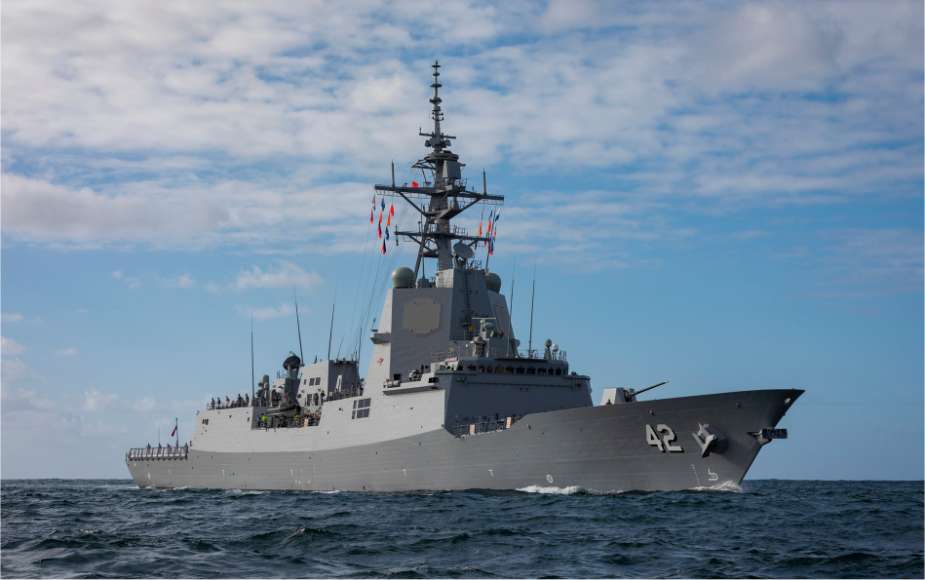Breaking news
Navantia wins contract for Australian Hobart class destroyers' Aegis design.
According to a PR published by Navantia on August 28, 2023, the Commonwealth of Australia has granted Navantia Australia the esteemed DDG Platform Systems Design contract.
Follow Navy Recognition on Google News at this link
 Australian Navy's Hobart class destroyer Sydney. (Picture source: RAN)
Australian Navy's Hobart class destroyer Sydney. (Picture source: RAN)
This contract positions Navantia Australia as the primary Platform Systems Designer for the SEA4000 Phase 6 Hobart class guided missile destroyer Combat Systems upgrade.
The award is set to bolster the Destroyer Capability Enhancement (DCE) program, which encompasses the transition to the advanced Aegis Baseline 9 under the SEA4000 Phase 6 initiative.
The DCE program is set to benefit from the combined efforts of top industry players. Navantia Australia, alongside Lockheed Martin Australia, Saab Australia, and BAE Systems Australia, will collaborate to work hand-in-hand with Defence.
Under the recently penned CSI Collaboration Agreement (CCA), Navantia Australia will extend its support to the Combat System Integration – Integrated Project Team (CSI-IPT). The aim is to streamline the incorporation of combat system elements into the Hobart Class Guided Missile Destroyers.
The partnership's focus remains on amplifying Australia's maritime integrated air and missile defence (IAMD) capabilities.
In addition, Navantia Australia is set to partner with Saab Australia to incorporate the Australian Interface. Based on Saab’s operational 9LV Combat Management System, this system will integrate through the CSI-IPT.
About the Hobart class
The destroyer has a displacement of 7,000 tonnes (6,900 long tons; 7,700 short tons) at full load and stretches 147.2 meters (483 feet) in length, with a maximum beam width of 18.6 meters (61 feet) and a draught of 5.17 meters (17.0 feet).
Its power is derived from a Combined Diesel or Gas (CODOG) arrangement, featuring two General Electric Marine model 7LM2500-SA-MLG38 gas turbines, each producing 17,500 kilowatts (23,500 hp), and two Caterpillar Bravo 16 V Bravo diesel engines, each generating 5,650 kilowatts (7,580 hp). This propulsion system drives two controllable pitch propellers, allowing the destroyer to achieve speeds of over 28 knots (52 km/h; 32 mph).
With a range of over 5,000 nautical miles (9,300 km; 5,800 mi) at a speed of 18 knots (33 km/h; 21 mph), the Hobart-class can undertake extended missions without needing frequent refueling. The vessel accommodates a crew of 186 personnel, with room for an additional 16 aircrew members, and offers facilities for up to 234 individuals.
Equipped with advanced sensors and processing systems, the Hobart-class destroyer features the Aegis combat system and Lockheed Martin AN/SPY-1D(V) S-band radar.
It also includes the Northrop Grumman AN/SPQ-9B X-band pulse Doppler horizon search radar and the Raytheon Mark 99 fire-control system with AN/SPG-62 continuous wave illuminating radars.
The destroyer's armament includes a 48-cell Mark 41 Vertical Launch System capable of deploying RIM-66 Standard 2 and RIM-162 Evolved Sea Sparrow missiles, along with two 4-canister Harpoon missile launchers.
It also features a Mark 45 (Mod 4) 5-inch gun, two Mark 32 Mod 9 two-tube torpedo launchers loaded with Eurotorp MU90 torpedoes, and a Phalanx CIWS.
The Hobart-class incorporates electronic warfare systems like the ITT EDO Reconnaissance and Surveillance Systems ES-3701 ESM radar, the SwRI MBS-567A communications ESM system, and Ultra Electronics Avalon Systems multipurpose digital receiver.


























